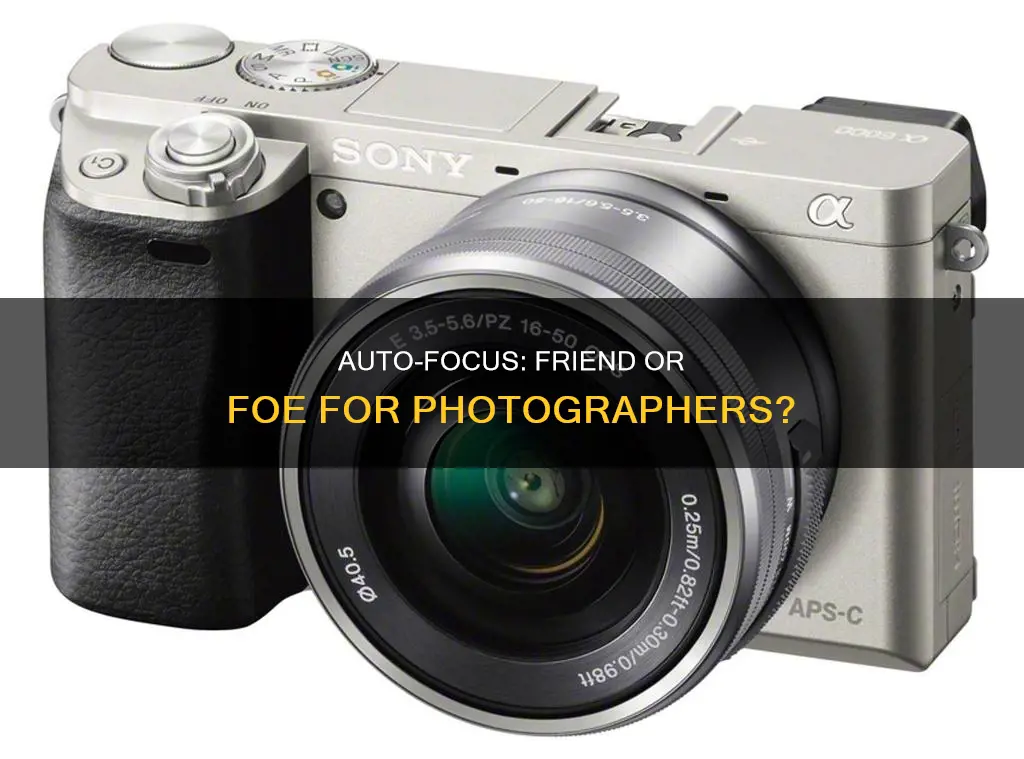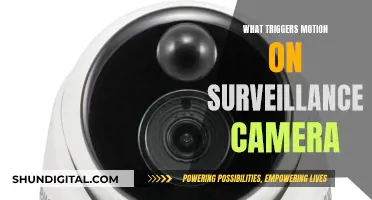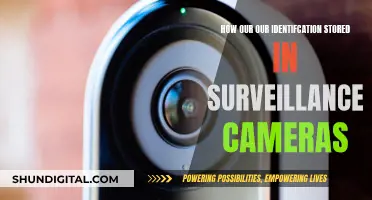
The autofocus feature on cameras has been described as the new megapixel, with big-name brands like Apple, Samsung, and LG investing in its innovation. Autofocus is a feature that automatically adjusts the camera lens to obtain focus on the subject, ensuring that the resulting image is sharp. While autofocus is generally fast and accurate, it is not always reliable, especially in low-light conditions or when tracking moving objects. In such cases, it may be preferable to focus manually. However, autofocus can be extremely useful in situations where the camera operator is juggling multiple tasks or when shooting with large formats, such as 4K video. Ultimately, the decision to use autofocus or manual focus depends on the specific circumstances and the type of lens being used.
What You'll Learn
- Autofocus is ideal for single or small numbers of roving subjects, especially in documentary projects, walk-and-talk interviews, or sports
- Autofocus is beneficial when constant light changes are occurring and the camera operator is also adjusting the iris
- Autofocus is useful when the camera is set to operate on its own, e.g. when mounted in a car or on a tracking vehicle
- Autofocus is helpful when using large formats, as it is difficult to focus with the naked eye
- Phase-detection AF is an improvement on contrast detection as it is faster and more accurate, and it informs the camera which direction to turn the focus wheel

Autofocus is ideal for single or small numbers of roving subjects, especially in documentary projects, walk-and-talk interviews, or sports
Autofocus is a useful tool in many photography and videography situations, especially when dealing with moving subjects. It is ideal for capturing single or small numbers of roving subjects, making it a valuable feature in documentary projects, walk-and-talk interviews, and sports photography.
In documentary filmmaking, autofocus has been widely adopted due to its ability to recognise and track faces, keeping them in sharp focus even at low f-stops. This is particularly useful when following a subject's movements or when the camera operator is also conducting an interview. While some filmmakers view autofocus as amateurish, it has improved significantly and can outperform humans in certain situations, such as smoothly tracking an object moving towards the camera.
For walk-and-talk interviews, autofocus can be beneficial when the interviewer is also operating the camera. It ensures the subject remains in focus even with slight movements, blinks, or twitches. However, some videographers still prefer manual focus in this situation, especially in low-light conditions or when a shallow depth of field is required.
In sports photography, autofocus is essential due to the fast-paced and unpredictable nature of the subject's movements. Continuous autofocus modes, such as AI Servo AF (Canon), Continuous AF (Sony), and AF-C (Nikon), are designed for this purpose. These modes use predictive artificial intelligence to analyse and predict the subject's movements, maintaining focus while shooting in continuous burst modes.
When shooting sports, it is also important to consider the number and type of autofocus points available on your camera. Higher-end cameras offer more autofocus points, improving the robustness and flexibility of autofocus. Additionally, certain focus modes, such as "Zone", "Expand", "Wide", or "Flexible Spot M", can be more suitable for erratic movements like those found in sports.
While autofocus has its limitations and may not be suitable for all shots, it is a valuable tool in these scenarios, allowing photographers and videographers to capture sharp images of moving subjects with ease.
Unlocking Camera Mode in Smash Melee: A Step-by-Step Guide
You may want to see also

Autofocus is beneficial when constant light changes are occurring and the camera operator is also adjusting the iris
Autofocus is a crucial feature in modern photography, providing users with peace of mind and allowing them to focus on other aspects of image composition, such as lighting and framing. While it may not be a deal-breaker for every photographer, autofocus is particularly beneficial in situations where speed and accuracy are essential to capture fleeting moments.
One of the key advantages of autofocus is its ability to intelligently adjust the camera lens to obtain sharp focus on the subject. This process occurs within a fraction of a second, ensuring that photographers don't miss out on capturing important moments. The autofocus system relies on sensors to determine the correct focus, with some cameras offering a single sensor and others utilising an array of sensors for improved accuracy.
In terms of the factors influencing autofocus performance, light levels play a crucial role. Constant light changes can be challenging for manual focus, but autofocus systems are designed to adapt to these variations. Additionally, autofocus can leverage techniques like active AF, which uses ultrasonic sound waves or infrared light to measure distance independently of the optical system. This is particularly useful when dealing with low-light conditions or subjects with low contrast, ensuring that the camera can still achieve accurate focus.
Another benefit of autofocus becomes apparent when the camera operator is adjusting the iris. The autofocus system can continuously adjust the focus distance, even while the iris is being modified. This dynamic capability ensures that the image remains sharp and in focus, even during rapid light changes or when the depth of field is shallow.
Moreover, autofocus systems offer different modes to cater to various scenarios. The one-shot mode, for instance, is ideal for still subjects, while the AI servo or continuous mode is better suited for moving subjects. The latter predicts the subject's future position based on its velocity, ensuring the camera maintains focus even as the subject moves around the frame.
In conclusion, autofocus is highly beneficial when dealing with constant light changes and iris adjustments. It provides speed, accuracy, and the ability to track moving subjects, all while allowing the photographer to focus on other creative aspects of capturing memorable images.
Wi-Fi Doorbell Cameras: Battery or Wired Power?
You may want to see also

Autofocus is useful when the camera is set to operate on its own, e.g. when mounted in a car or on a tracking vehicle
Autofocus is a highly useful feature when the camera is set to operate on its own. This is especially true when the camera is mounted in a car or on a tracking vehicle, where the photographer cannot manually adjust the focus. In such situations, autofocus can be the difference between a sharp photo and a missed opportunity.
Autofocus (AF) systems use a combination of sensors, control systems, and motors to focus on a selected point or area. They can be categorised into active, passive, or hybrid types. Active AF systems measure the distance to the subject independently of the optical system and then adjust the focus accordingly. Passive AF systems, on the other hand, perform passive analysis of the incoming image to determine the correct focus. Hybrid systems combine two or more methods to compensate for the weaknesses of individual methods and increase overall reliability and accuracy.
Passive AF systems can further be divided into phase detection and contrast detection methods. Phase detection works by dividing the incoming light into pairs of images and comparing them. Contrast detection, on the other hand, measures the contrast within a sensor field and adjusts the focus to achieve maximal contrast. While phase detection is generally faster and more accurate, contrast detection has the advantage of not requiring actual distance measurement.
Most modern cameras offer autofocus capabilities, and photographers often rely on this feature due to its ease of use and effectiveness. Canon, for instance, offers AI Servo AF for moving subjects, which continually adjusts the focus as the subject moves. This is particularly useful when the camera is mounted on a vehicle, as it allows the photographer to capture sharp images without having to manually adjust the focus.
In conclusion, autofocus is indeed useful when the camera is set to operate on its own, especially in situations where the subject is moving or the photographer cannot manually adjust the focus. By utilising either active or passive AF systems, or a combination of both, cameras can automatically adjust the focus to ensure sharp images are captured.
Understanding Panoramic Photography: Pano Mode in Cameras
You may want to see also

Autofocus is helpful when using large formats, as it is difficult to focus with the naked eye
Autofocus is a comparatively new invention in the history of photography, first appearing on the market in 1977. Autofocus systems use a motor in the camera or lens to focus on a subject you’ve selected manually or automatically. Autofocus is helpful when using large formats as it is difficult to focus with the naked eye.
The autofocus system intelligently adjusts the camera lens to obtain focus on the subject, which can mean the difference between a sharp photo and a missed opportunity. Autofocus (AF) works either by using contrast sensors within the camera (passive AF) or by emitting a signal to illuminate or estimate the distance to the subject (active AF).
Passive AF can be performed using either the contrast detection or phase detection methods, but both rely on contrast for achieving accurate autofocus. The process of autofocusing generally works as follows:
- An autofocus processor (AFP) makes a small change in the focusing distance.
- AFP reads the AF sensor to assess whether and by how much focus has improved.
- Using the information from step 2, the AFP sets the lens to a new focusing distance.
- The AFP may iteratively repeat steps 2-3 until satisfactory focus has been achieved.
This entire process is usually completed within a fraction of a second. For difficult subjects, the camera may fail to achieve satisfactory focus and will give up on repeating the above sequence, resulting in failed autofocus. This is the dreaded "focus hunting" scenario where the camera focuses back and forth repeatedly without achieving focus lock.
Autofocus is especially handy for focusing on unpredictably moving subjects because cameras can usually make corrections faster than you. Most photographers use autofocus more often than manual focus. The main reason is convenience; it’s easier than focusing manually. Autofocus also tends to be faster and, in many cases, it’s also more accurate (such as tracking focus on a moving subject). This is why sports and wildlife photographers tend to rely on autofocus so heavily.
Autofocus technology has come a long way, and in the last few years, we've seen giant leaps in face tracking and low light level autofocus performance, especially when talking about Sony cameras. The Sony Cinema Line, including VENICE, the FX9, FX6, and FX3, offers robust Hybrid AF that combines phase detection AF and contrast-detection AF for some of the best speed and precision on the market.
Autofocus is also very useful when you are a one-man band, shooting documentary B-roll, shooting interviews, shooting higher resolution, or vlogging/self-shooting.
GoPro Cameras: Made in the USA?
You may want to see also

Phase-detection AF is an improvement on contrast detection as it is faster and more accurate, and it informs the camera which direction to turn the focus wheel
Phase-Detection AF: An Improvement on Contrast Detection
Phase-detection autofocus is an improvement on contrast detection autofocus as it is faster, more accurate, and informs the camera which direction to turn the focus wheel.
How Phase-Detection AF Works
Phase-detection autofocus (AF) works by analysing the light as it passes through the lens. The camera compares light from two apertures on opposite sides of the lens. When the light rays overlap, the image is in focus. If the image is out of focus, the system can determine how much the focus needs to be adjusted.
Advantages of Phase-Detection AF Over Contrast Detection
Phase-detection AF has several advantages over contrast detection:
- Speed and Accuracy: Phase-detection AF is faster and more accurate than contrast detection, especially for moving subjects. It can focus an image in around 0.3 seconds, approximately three times faster than contrast detection. This reduces the risk of missing a shot in fast-moving scenes, such as sports games.
- Continuous Autofocus: Phase-detection AF enables continuous autofocus, keeping moving objects sharp and in focus, which is important for video recording.
- Direction of Focus Wheel: Phase-detection AF informs the camera which direction to turn the focus wheel, unlike contrast detection.
Limitations of Phase-Detection AF
Despite its advantages, phase-detection AF has some limitations:
- Low-Light Performance: Similar to contrast detection, phase-detection AF struggles in low-light conditions as it relies on analysing incoming light.
- Availability: Phase-detection AF is only available on select high-end smartphones and DSLR cameras.
- Cost and Weight: Phase-detection AF is more costly and heavier than contrast detection due to the additional hardware required.
- Live View and Movie Mode: Phase-detection AF does not work in Live View or movie mode in DSLRs as the camera's mirror blocks light to the autofocus unit.
- Wide Apertures: Phase-detection AF is prone to errors when focusing with wide apertures due to mechanical tolerances.
Hybrid Autofocus Systems
Some modern cameras, such as the Sony a6600, feature hybrid autofocus systems that combine phase-detection and contrast-detection technologies. These systems typically start with phase-detection AF for quick initial focusing and then switch to contrast detection to refine the edges, resulting in the sharpest possible image.
Partial Charging: Does It Damage Camera Batteries?
You may want to see also
Frequently asked questions
Yes, autofocus (AF) is a great feature to use, especially if you are a beginner. It is fast and accurate and will ensure your images are sharp.
There are two main types of autofocus: passive AF and active AF. Passive AF uses contrast sensors within the camera, while active AF emits a signal to estimate the distance to the subject.
Autofocus is fast and accurate, ensuring your images are sharp. It is also useful when shooting video, as it can keep a moving subject in focus.
Autofocus may struggle in low-light conditions or when there is little contrast in the scene. It may also not work well if the subject is moving too quickly.







